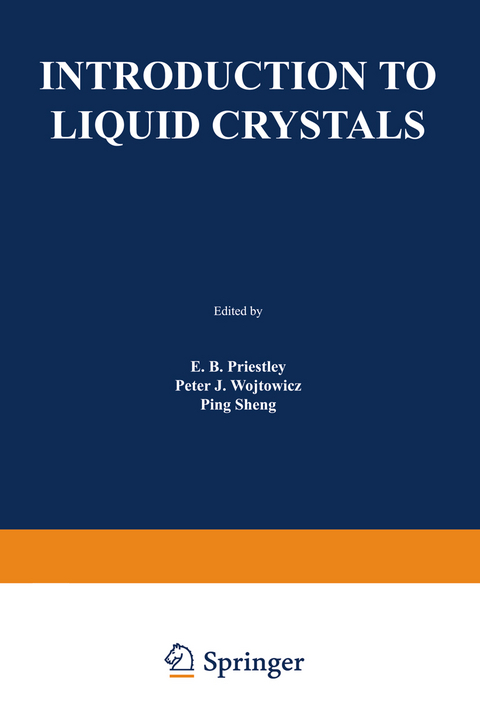
Introduction to Liquid Crystals
Springer-Verlag New York Inc.
978-1-4684-2177-4 (ISBN)
The existence of liquid crystals has been known for nearly a centu ry; yet it is only in the last ten years that their unique optical, electri cal, electro-optic, and thermal properties have been exploited to any significant extent in such technological applications as digital d~ plays and thermography. Digital watches equipped with liquid-crys tal displays (LCD's) have recently made their debut in the electronic watch market, and the large-scale use of LCD's in a variety of other applications requiring reliable, low-power digital displays is immi nent. There is good reason to believe that liquid crystals will be the first electro-optic materials to find widespread commercial use. Apart from applications, liquid crystals are unique among the phases of matter. Lurking beneath their garish display of color and texture is a great complexity of physical and chemical interaction that is only now beginning to unfold in the face of a decade-old resurgence in all aspects of liquid~rystal research. RCA Laboratories has participated in this resurgence from its beginning in the early 1960's and at present maintains active liquid-crystal programs both in basic re search and in device engineering. In view of the widespread interest in liquid crystals at RCA Labo ratories, an in-house weekly seminar devoted to the subject of liquid crystals was organized in the fall of 1973. The resulting lectures were subsequently published in three issues of the RCA Review and, with the incorporation of much additional material, eventually grew into the present volume.
1 Liquid Crystal Mesophases.- 1. Mesophases.- 2. Types of Liquid Crystals.- 3. Classification According to Molecular Order.- 4. Polymorphism in Thermotropic Liquid Crystals.- 5. Molecular Structure of Thermotropic Mesogens.- 6. Properties of Ordered Fluid Mesophases.- 2 Structure-Property Relationships in Thermotropic Organic Liquid Crystals.- 1. Introduction.- 2. Organic Mesophases.- 3. General Structural Features of Mesogens.- 4. Effects of Structure on Mesophase Thermal Stability.- 5. Homologous Series.- 6. Materials for Device Applications.- 7. Summary.- 3 Introduction to the Molecular Theory of Nematic Liquid Crystals.- 1. Introduction.- 2. Symmetry and the Order Parameter.- 3. The Molecular Potential.- 4. The Orientational Distribution function.- 5. Thermodynamics of the Nematic Phase.- 6. Fluctuations at Tc.- 4 Generalized Mean Field Theory of Nematic Liquid Crystals.- 1. Introduction.- 2. The Pair Interaction Potential.- 3. The Mean Field Approximation.- 4. Statistical Thermodynamics.- 5. Nature of the Parameters UL.- 6. The Need for Higher Order Terms in V1.- 5 Hard Rod Model of the Nematic-Isotropic Phase Transition.- 1. Introduction.- 2. Derivation of Onsager Equations.- 3. Solution of Onsager Equations in a Simplified Case.- 6 Nematic Order: The Long Range Orientational Distribution Function.- 1. Introduction.- 2. The Orientational Distribution function.- 3. Macroscopic Definition of Nematic Order.- 4. Relationship Between Microscopic and Macroscopic Order Parameters.- 5. Experimental Measurements.- 6. Experimental Data.- 7 Introduction to the Molecular Theory of Smectic-A Liquid Crystals.- 1. Introduction.- 2. Symmetry, Structure and Order Parameters.- 3. Phase Diagrams.- 4. The Molecular Potential.- 5. Statistical Thermodynamics.- 6. Numerical Results.- 7.Improved Theory.- 8. The Possibility of Second-Order Transitions.- 8 Introduction to the Elastic Continuum Theory of Liquid Crystals.- 1. Introduction.- 2. The Fundamental Equation of the Continuum Theory of Liquid Crystals.- 3. Applications of the Elastic Continuum Theory.- 4. Concluding Remarks.- 9 Electrohydrodynamic Instabilities in Nematic Liquid Crystals.- 1. Introduction.- 2. Nature of the Instability and the Balance of Forces.- 3. Dielectric Response.- 4. Hydrodynamic Effects.- 5. The Boundary Value Problem in the Conduction Regime.- 6. The Torque Balance Equation.- 7. Numerical Results and Comparison with Experiment.- 8. Range of Applicability.- 10 The Landau-de Gennes Theory of Liquid Crystal Phase Transitions.- 1. Introduction.- 2. Derivation of the Fundamental Equations of the Landau-de Gennes Theory.- 3. Thermodynamic Properties of Liquid Crystal Phase Transitions.- 4. Fluctuation Phenomena.- 5. Observation of Fluctuations Using Light Scattering.- 6. Magnetic Birefringence and the Paranematic Susceptibility.- Appendix A.- Appendix B.- 11 Introduction to the Optical Properties of Cholesteric and Chiral Nematic Liquid Crystals.- 1. Introduction.- 2. Maxwell’s Equations.- 3. Discussion.- 4. Conclusion.- Appendix A.- Appendix B.- 12 Liquid-Crystal Displays—Packaging and Surface Treatments.- 1. Introduction.- 2. Packaging.- 3. Electrodes.- 4. Surface Orientation.- 5. Influence of Packaging on Surface Orientation.- 6. Summary.- 13 Pressure Effects in Sealed Liquid-Crystal Cells.- 1. Introduction.- 2. Effect of Temperature Change.- 3. Effect of Glass Thickness.- 4. The Case of a Rigid Container.- 14 Liquid-Crystal Displays—Electro-optic Effects and Addressing Techniques.- 1. Introduction.- 2. Electro-optic Phenomena.- 3. Display-Related Parameters.- 4.Addressing Techniques.- 5. Summary.- 15 Liquid-Crystal Optical Waveguides.- 1. Introduction.- 2. Guided Optical Waves.- 3. Phase Matching and Coupling.- 4. Scattering.- 5. Liquid Crystal Waveguides.- 6. Conclusions.- 16 The Electro-optic Transfer Function in Nematic Liquids.- 1. Introduction.- 2. Geometrical Considerations in Optical Measurements.- 3. Field Effects—Negative Dielectric Anisotropy.- 4. Field Effects—Positive Dielectric Anisotropy.- 5. Hydrodynamic Effects—Diffraction by Domains.- 6. Dynamic Scattering.- 7. Photoconductor Control.- 17 Electrochemistry in Nematic Liquid-Crystal Solvents.- 1. Introduction.- 2. Equilibrium Properties of Bulk Solutions.- 3. Electrochemical Reactions.- 18 Lyotropic Liquid Crystals and Biological Membranes: The Crucial Role of Water.- 1. Introduction.- 2. Lyotropic Liquid Crystals.- 3. Biological Membranes.- 4. Interaction of Amphiphilic Compounds with Water.- 5. Conclusion.
| Zusatzinfo | XII, 356 p. |
|---|---|
| Verlagsort | New York, NY |
| Sprache | englisch |
| Maße | 152 x 229 mm |
| Themenwelt | Naturwissenschaften ► Geowissenschaften ► Mineralogie / Paläontologie |
| Naturwissenschaften ► Physik / Astronomie ► Atom- / Kern- / Molekularphysik | |
| Naturwissenschaften ► Physik / Astronomie ► Optik | |
| Technik ► Elektrotechnik / Energietechnik | |
| ISBN-10 | 1-4684-2177-8 / 1468421778 |
| ISBN-13 | 978-1-4684-2177-4 / 9781468421774 |
| Zustand | Neuware |
| Haben Sie eine Frage zum Produkt? |
aus dem Bereich


